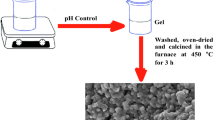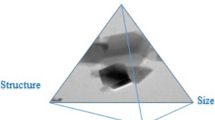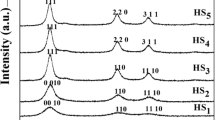Abstract
Nanoparticles were applied to a crystal surface to increase its precursor adsorption efficiency in an attenuated total reflection Fourier transform infrared (ATR-FTIR) spectrometer. Nanoparticles with varying dispersion stabilities were employed and the resulting precursor adsorption characteristics were assessed. The size of the nanoparticles was <100 nm (TEM). In order to vary the dispersion stability, ZrO2 nanoparticles were dispersed in aqueous solutions of different pH. The ZrO2 dispersion solutions were analyzed using scanning electron microscopy (SEM) while particle distribution measurements were analyzed using electrophoretic light scattering (ELS) and dynamic light scattering (DLS) techniques. ZrO2 nanoparticles dispersed in solutions of pH 3 and 11 exhibited the most stable zeta potentials (≥+30 or ≤−30 mV); these observations were confirmed by SEM analysis and particle distribution measurements. Hexamethyldisilazane (HMDS) was used as a precursor for ATR-FTIR spectroscopy. Consequently, when ZrO2 nanoparticle solutions with the best dispersion stabilities (pH 3 and 11) were applied to the adsorption crystal surface, the measurement efficiency of ATR-FTIR spectroscopy improved by ∼200 and 300%, respectively.





Similar content being viewed by others
References
Bisesier JGP, Mcdermott AM, Yin Y, Sambrook RM, Vaidhyamatham B (2006) In situ coagulation moulding: a new route for high quality, net shape ceramics. Ceram Int 32:29–35. doi:10.1016/j.ceramint.2004.12.006
Chinchamlatpure VR, Chore SM, Patil SS, Chaudhari GN (2012) Synthesis and electrical characterization of ZrO2 thin films on Si(100). J Mod Phys 3:69–73. doi:10.4236/jmp.2012.31010
Dai M, Kwon J, Langereis E, Wielunski LS, Chabal Y, Li Z, Gordon R (2007) In-situ FTIR study of atomic layer deposition (ALD) of copper metal films. ECS Trans 11:91–101. doi:10.1149/1.2779073
Decanio EC, Edwards JC, Scalzo TR, Storm DA, Bruno JW (1991) FT-IR and solid-state NMR investigation of phosphorus promoted hydrotreating catalyst precursors. J Catal 132:498–511. doi:10.1016/0021-9517(91)90166-2
Delgado AV, Arroyo FJ (2002) Electric phenomena and their experimental determination: an overview. In: Delgado AV (ed) Interfacial electrokinetics and electrophoresis. Marcel Dekker, New York, pp 1–54
Dhar S, Dharmaprakash MS, Shivashankar SA (2008) MOCVD of ZrO2 films from bis(t-butyl-3-oxo-butanoato)zirconium(IV): some theoretical (thermodynamic) and experimental aspects. Bull Mater Sci 31:67–72. doi:10.1007/s12034-008-0012-6
Elimelech M, Nagai M, Ko C, Ryan JN (2000) Relative insignificance of mineral grain zeta potential to colloid transport in geochemically heterogeneous porous media. Environ Sci Technol 34:2143–2148. doi:10.1021/es9910309
Friz M, Waibel F (2003) Coating materials. In: Kaiser N, Pulker H (eds) Optical interference coatings, volume 88. Springer Berlin Heidelberg, Berlin, pp 105–130
Gauckler LJ, Graule TH, Baader F (1999) Ceramic forming using enzyme catalyzed reactions. Mater Chem Phys 61:78–102. doi:10.1016/S0254-0584(99)00117-0
Gordon RG, Barry S, Broomhall-Dillard RNR, Wagner VA, Wang Y (2000) Volatile liquid precursors for the chemical vapor deposition (CVD) of thin films containing tungsten. Mater Res Soc Symp Proc 612:D9.12.1–D9.12.6
Gordon PG, Kurek A, Barry ST (2015) Trends in copper precursor development for CVD and ALD applications. ECS J Solid State Sci Technol 4:N3188–N3197. doi:10.1149/2.0261501jss
Kim J, Lawler DF (2005) Characteristics of zeta potential distribution in silica particles. B Kor Chem Soc 26:1083–1089. doi:10.5012/bkcs.2005.26.7.1083
Lee B, Choi KJ, Hande A, Kim MJ, Wallace RM, Kim J, Senzaki Y, Shenai D, Li H, Rosseau M, Suydam J (2009) A novel thermally-stable zirconium amidinate ALD precursor for ZrO2 thin films. Microelectron Eng 86:272–276. doi:10.1016/j.mee.2008.03.020
Letterman RD (1999) Water quality and treatment, 5th edn. McGrawHill, New York, pp 6.1–6.43
Matysik S, Klünemann HH, Schmitz G (2012) Gas chromatography–tandem mass spectrometry method for the simultaneous determination of oxysterols, plant sterols, and cholesterol precursors. Clin Chem 58:1557–1564. doi:10.1373/clinchem.2012.189605
Prajapati RR, Srinivasan TG, Chandramouli V, Bhagwat SS (2014) Dissolution kinetics of zirconium dioxide in nitric acid. Desalin Water Treat 52:490–497. doi:10.1080/19443994.2013.808804
Pugh RJ, Bergström L (1994) Surface and colloidal chemistry in advanced ceramics processing. Marcel Dekker Inc., New York, pp 94–104
Shin J-S, Park M-S, Jung W-J, Park H-J, Yun J-Y, Kim T, Kang S-W (2015) The study on the precursor adsorption using in-situ nanoparticle-assisted attenuated total reflectance infrared spectroscopy. Appl Sci Converg Technol 24:90–95. doi:10.5757/ASCT.2015.24.4.90
Stumm W, Morgan JJ (1996) Aquatic chemistry: chemical equilibria and rates in natural waters, 3rd edn. Wiley-Interscience, New York, pp 516–586
Zhang Y, Binner J (2008) Effect of dispersants on the rheology of aqueous silicon carbide suspensions. Ceram Int 34:1381–1386. doi:10.1016/j.ceramint.2007.03.030
Acknowledgments
This work was supported by the Korea Spectral Products (KSP) funded by the Ministry of Trade, Industry, and Energy (MOTIE) (Project No. 10062326, the development and commercialization of the real-time quantitative optical diagnostic system for monitoring gas absorption in the wavelength range of 0.2–50 μm and nanometer-sized contaminant particles).
Author information
Authors and Affiliations
Corresponding author
Ethics declarations
Conflict of interest
The authors declare that they have no conflict of interest.
Research involving human participants and/or animals
Not applicable.
Informed consent
Not applicable.
Additional information
Jaeseo Park and Jihun Mun contributed equally to this work.
Rights and permissions
About this article
Cite this article
Park, J., Mun, J., Shin, JS. et al. Improving precursor adsorption characteristics in ATR-FTIR spectroscopy with a ZrO2 nanoparticle coating. J Nanopart Res 19, 45 (2017). https://doi.org/10.1007/s11051-017-3767-0
Received:
Accepted:
Published:
DOI: https://doi.org/10.1007/s11051-017-3767-0




